What is tobiko and how to use it? This tobiko sushi is the perfect easy and delicious sushi recipe using orange tobiko caviar. You will also learn about different types of tobiko flying fish eggs including black, green and red roe.
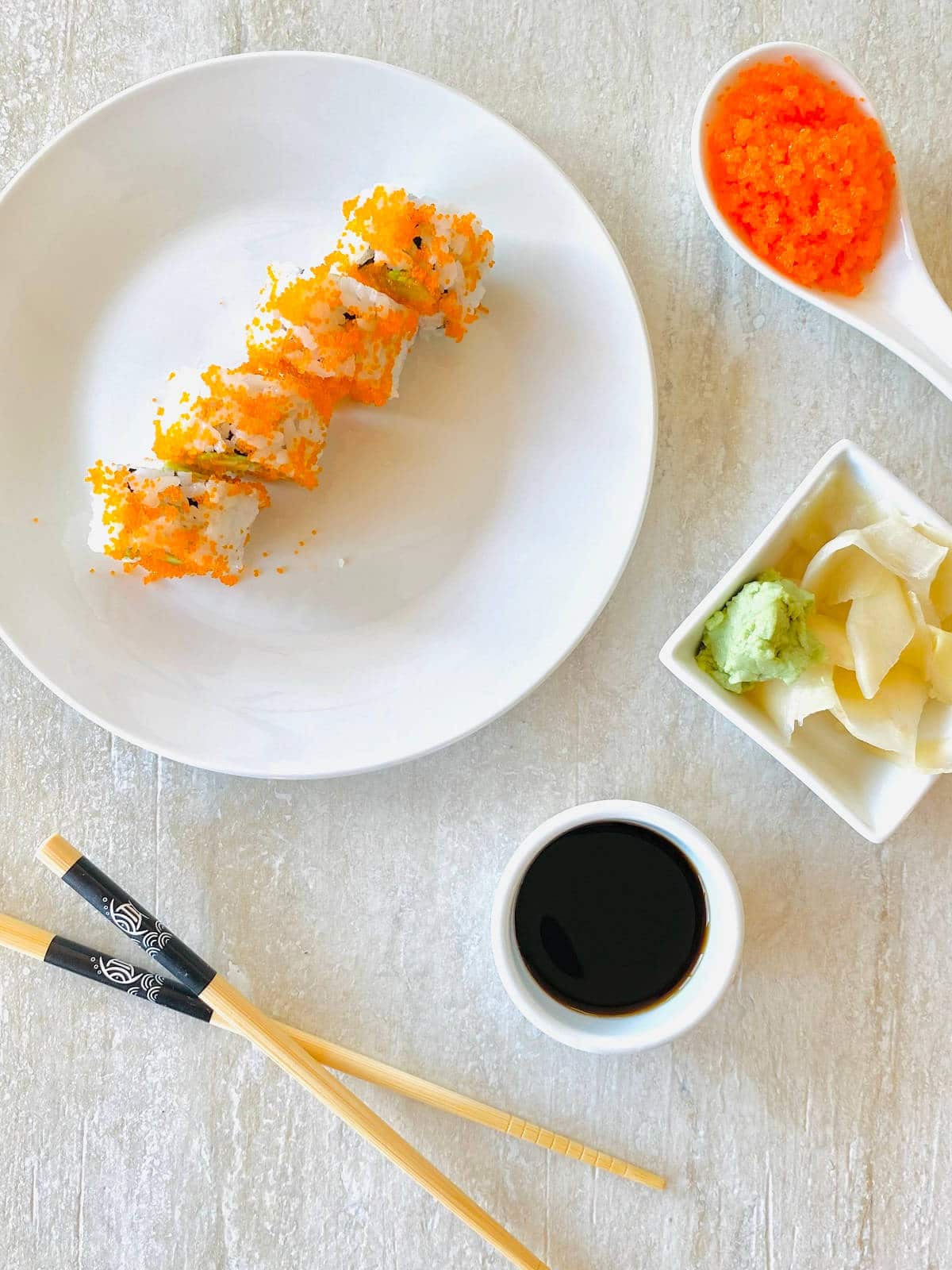
This post may contain affiliate links which means I may receive commissions if you choose to purchase through this link (at no extra cost to you).
If you are a sushi lover, you cannot go wrong with tobiko sushi! Tobiko sushi is a sushi roll that is filled with crab (sometimes shrimp or other seafood), avocado and crab.
It is then rolled in or topped with tobiko roe (flying fish roe). Orange tobiko is the most common color of tobiko that you see on fish roe sushi.
You can also find other exciting colors such as black tobiko, red tobiko, yellow tobiko (golden tobiko), and green tobiko (wasabi tobiko).
If you love sushi, definitely check out this Red Dragon Roll, Spicy Kani Roll, Alaska Roll Sushi, Sweet Potato Sushi Roll and Vegetable Sushi!
Tobiko is one of the favorite natural ingredients used in Japanese cuisine that has a vibrant orange color. No food coloring needed to achieve a strikingly beautiful sushi dish.
Both masago eggs and tobiko are full of fatty acids and are often used as a coating on California rolls.
These tiny eggs are bright orange with a mild taste and briny flavor. You can purchase tobiko in Asian grocery stores or at the local sushi counter.
Tobiko is sometimes confused with other versions of Japanese caviar, Japanese salmon eggs or capelin fish. Be sure to specify tobiko or masago.
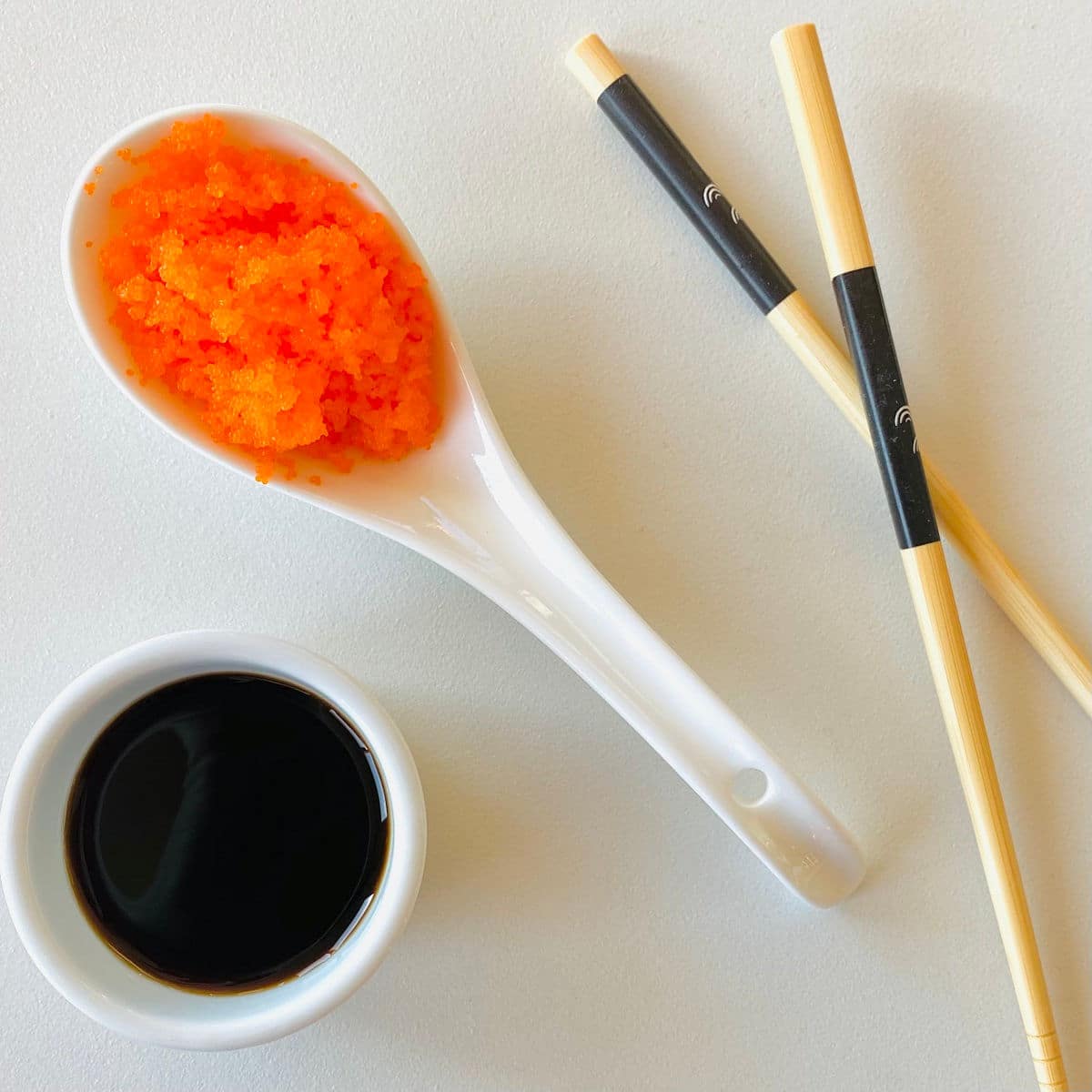
Why this recipe works
- This is a great introductory sushi recipe that is next level beautiful by adding tobiko roe!
- Tobiko sushi can be made in a variety of different colors depending on the tobiko roe that you choose.
- Only a few ingredients required and super healthy!
Ingredients for tobiko sushi
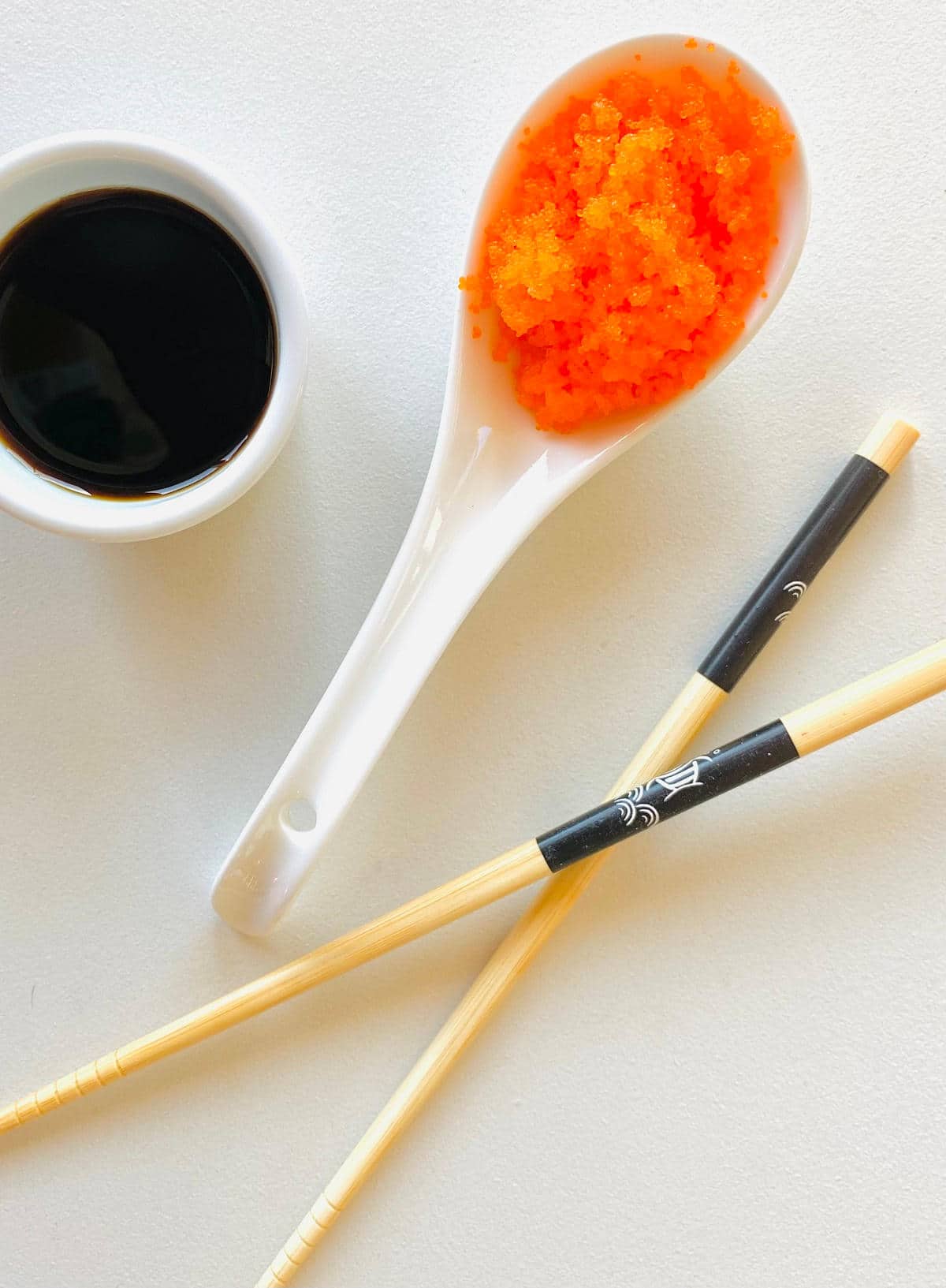
Sushi Rice
Rice: You will want to use a short grain (Japanese rice) or medium grain (California) rice. Some excellent sushi rice brands are: Lundberg Organic California Sushi Rice, Botan Calrose Rice or Nishiki Premium Grade Rice.
Seasoned Rice Vinegar: I recommend seasoned rice wine vinegar. Marukan Seasoned Rice Vinegar and Nakano Seasoned Rice Vinegar are both good choices and are often found in the Asian or vinegar/salad dressing section of most grocery stores. Many grocery stores also carry a store brand version of rice vinegar (ex: target).
Water
Salt
Tobiko Sushi
Tobiko (flying fish roe) or Masago: Tobiko can be a bit tricky to find. You can purchase orange tobiko online, as well different tobiko variations such as black tobiko, wasabi tobiko and yellow tobiko online.
You can also buy a small amount from your local Sushi restaurant. That is typically the easiest way to get started.
Nori Seaweed Paper: You can buy nori sheets at most grocery stores in the Asian section. You can also find a large variety of roasted nori seaweed sheets on Amazon.
Imitation Crab Meat (Sticks): Also called surimi seafood, krab, crab sticks or kamaboko.
Cucumber
Avocado
Pickled ginger (optional): If you would like to make your own, you can head over to my Quick Pickled Vegetables recipe which works great to make pickled ginger. You can also buy pink pickled ginger or white pickled ginger on Amazon or at most local supermarkets in the Asian section.
Wasabi (optional): While can buy pre-made wasabi paste and many grocery stores or online, if you want to know how to make wasabi, I would recommend that you buy wasabi powder. Personally, I think that wasabi made with wasabi powder tastes fresher and more potent. Wasabi is super easy to make! You simply add water to the wasabi powder and BOOM, you have the awesome wasabi that you get in Japanese restaurants.
Optional Sauces and Toppings
- Spicy Sriracha Mayo
- Bang Bang Sauce: Easy recipe. Who doesn’t like sweet and spicy!
- Eel Sauce: My homemade recipe for eel sauce is super easy!
- White or black sesame seeds
Instructions to make flying fish roe sushi
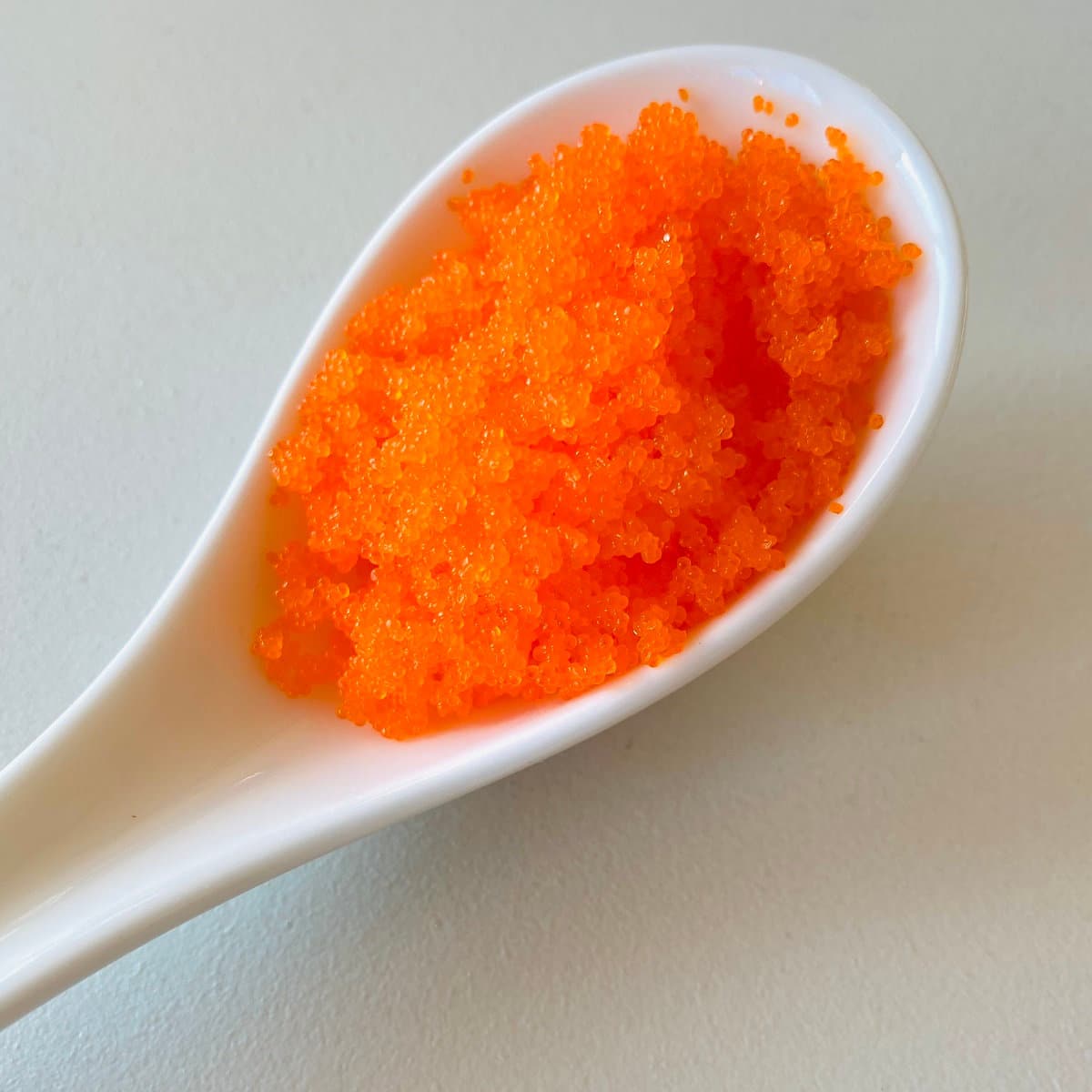
How to make sushi rice
Instant Pot Sushi Rice is super easy to make.
Rinse the rice in a fine mesh strainer to remove excess starch (water should run clean). Shake off excess water.
Add rinsed rice and salt to instant pot. Add water. Add 1 teaspoon salt.
Cook on instant pot high pressure setting for 6 minutes (with full natural release).
Transfer rice to bowl. Add rice vinegar evenly over rice.
Gently fold rice to incorporate rice vinegar, be careful not to smash rice.
How to roll Tobiko Sushi
Cover a bamboo sushi rolling mat with plastic wrap.
Place a sheet of nori on the mat.
Dip hands in water and clap to remove excess water. It helps to keep small bowl of water near you and a towel.
Spread a layer of rice across the nori. You will use about 1 cup cooked rice per full nori sheet.
Spread rice over whole surface of nori (no gap). Lay slices of salmon evenly over half.
Flip nori over (rice/salmon side down, nori up).
Place 2 sticks imitation surimi crab, 2 slices avocado and 3-4 thin cucumber strips lengthwise in a strip across the rice. Placement should be about 1 inch or so from the bottom of the rice paper. Be careful not to put too many or sushi roll will not close well.
Use bamboo mat to lift edges up and over filling. Use fingers to tuck roll.
Tuck mat tightly into roll shape so only nori with no rice is exposed, pull back and tighten.
Move mat and shape roll, repeat squeeze and shape.
Slice and wipe with wet towel after each slice to prevent knife from getting too sticky.
Cut in half and then each half into 3 segments.
Top or roll your tobiko sushi with tobiko flying fish roe
Depending on your taste, you can sprinkle tobiko roe on top of your tobiko sushi.
Alternatively, you can place an even layer of tobiko roe on plate and press your tobiko sushi roll into the layer of tobiko.
You can use this tobiko sushi recipe with orange tobiko, red tobiko, black tobiko, green tobiko (wasabi tobiko), yellow tobiko or masago.
Leftovers and Storage: Eat immediately. Do not store.
What is tobiko?
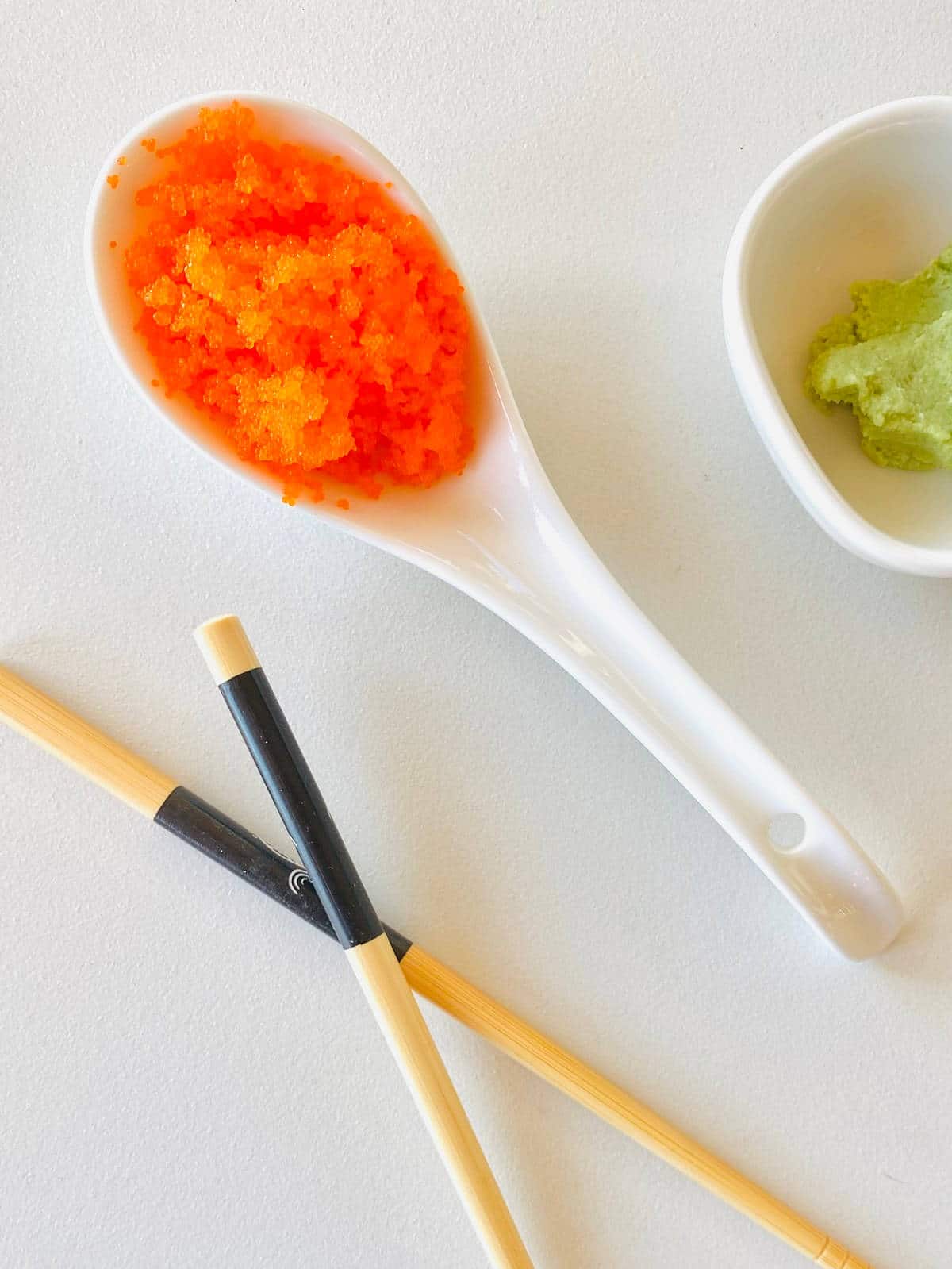
Tobiko means flying fish roe (Japanese). It is an excellent topping for many different types of sushi.
Tobiko eggs are smaller than salmon roe and larger than masago (capelin roe) and have a umami, smoky taste and crunchy texture.
Tobiko is typically orange in color but can also be colored with squid ink (black tobiko), yuzu (yellow or golden tobiko) or wasabi (green tobiko).
FAQ and expert tips
Black tobiko is flying fish roe colored with squid ink to achieve the black color.
Red tobiko is flying fish roe that is red in hue.
Green tobiko, also known as wasabi tobiko, is flying fish roe colored with wasabi to achieve the green color.
Wasabi tobiko, also known as green tobiko, is flying fish roe colored with wasabi to achieve the green color.

Looking for other delicious Asian inspired recipes?
Hungry for more? Subscribe to my EMAIL NEWSLETTER and follow me on Facebook, Instagram and Pinterest for all of the latest delicious food!
You can also comment below. I LOVE hearing from you! If you loved the recipe, a 5 STAR RATING is the ultimate compliment as food is my love language!
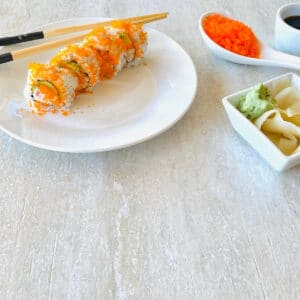
Tobiko Sushi
Equipment
- Instant pot (sushi rice), bamboo sushi mat, plastic wrap
Ingredients
Sushi Rice
- 1 cup small or medium grain white rice
- 1 cup + 1 tbsp water
- 2 tablespoon seasoned rice vinegar
- 1 teaspoon salt
Tobiko Sushi
- 1 sheet nori (seaweed paper)
- 2 sticks imitation crab meat (also called, surimi seafood, krab, crab sticks or kamaboko)
- 2-3 slices cucumber (cut into matchsticks)
- 2-3 slices avocado
- pickled ginger (optional)
- wasabi (optional)
- 2 tablespoons tobiko (flying fish roe) or masago
Optional Sauces and Toppings
- spicy sriracha mayo
- bang bang sauce
- eel sauce
- white or black sesame seeds
Instructions
How to make sushi rice
- Rinse the rice in a fine mesh strainer to remove excess starch (water should run clean). Shake off excess water.
- Add rinsed rice and salt to instant pot. Add water. Add 1 teaspoon salt.
- Cook on instant pot high pressure setting for 6 minutes (with full natural release).
- Transfer rice to bowl. Add rice vinegar evenly over rice.
- Gently fold rice to incorporate rice vinegar, be careful not to smash rice.
How to roll Tobiko Sushi
- Cover a bamboo sushi rolling mat with plastic wrap.
- Place a sheet of nori on the mat.
- Dip hands in water and clap to remove excess water. It helps to keep small bowl of water near you and a towel.
- Spread a layer of rice across the nori. You will use about 1 cup cooked rice per full nori sheet.
- Spread rice over whole surface of nori (no gap). Lay slices of salmon evenly over half.
- Flip nori over (rice/salmon side down, nori up).
- Place 2 sticks imitation surimi crab, 2 slices avocado and 3-4 thin cucumber strips lengthwise in a strip across the rice. Placement should be about 1 inch or so from the bottom of the rice paper. Be careful not to put too many or sushi roll will not close well.
- Use bamboo mat to lift edges up and over filling. Use fingers to tuck roll.
- Tuck mat tightly into roll shape so only nori with no rice is exposed, pull back and tighten.
- Move mat and shape roll, repeat squeeze and shape.
- Slice and wipe with wet towel after each slice to prevent knife from getting too sticky.
- Cut in half and then each half into 3 segments.
Add Tobiko
- Depending on your taste, you can sprinkle tobiko roe on top of your tobiko sushi. Alternatively, you can place an even layer of tobiko roe on plate and press your tobiko sushi roll into the layer of tobiko.
Notes
- You can use this tobiko sushi recipe with orange tobiko, red tobiko, black tobiko, green tobiko (wasabi tobiko), yellow tobiko or masago.
- Leftovers and Storage: Eat immediately. Do not store.


Leave a Reply